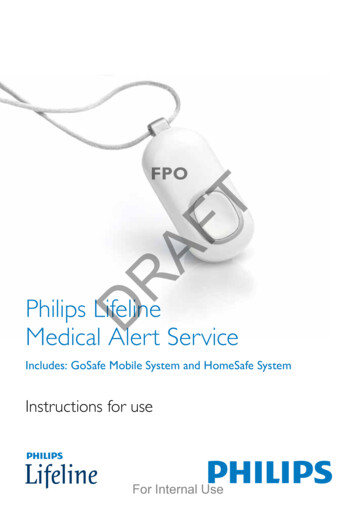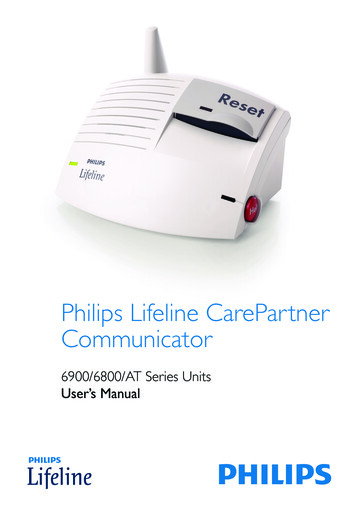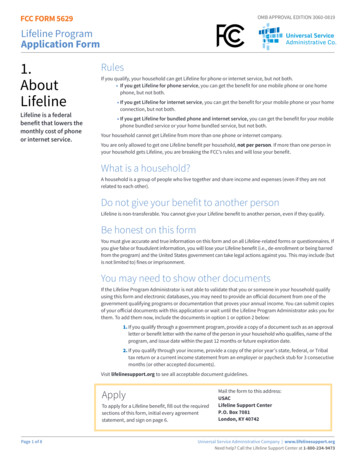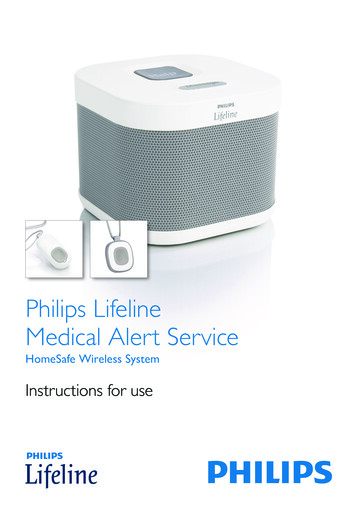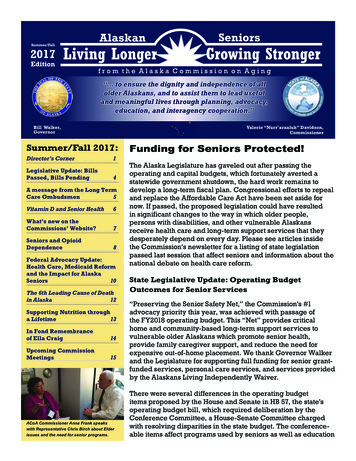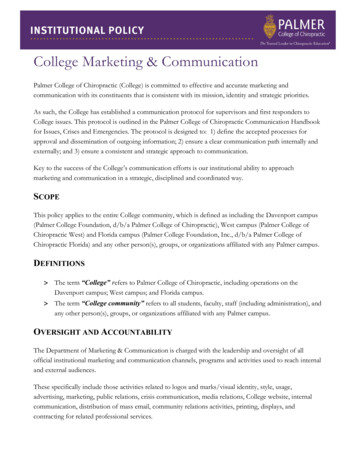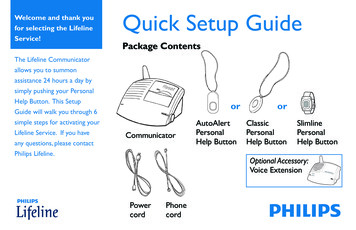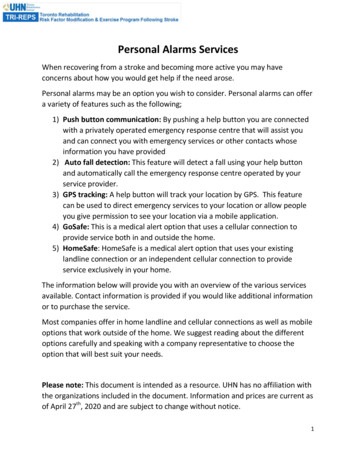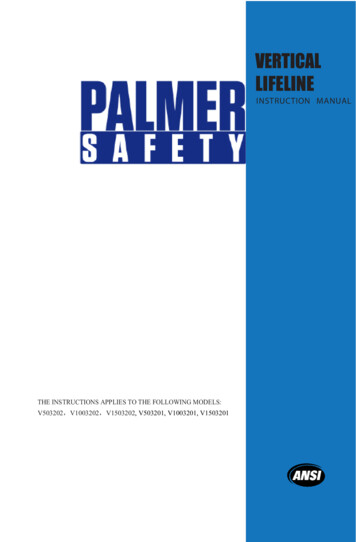
Transcription
LIFELINEINSTRUCTION MANUALTHE INSTRUCTIONS APPLIES TO THE FOLLOWING MODELS:V503202,V1003202,V1503202, V503201, V1003201, V1503201
Vertical Lifeline AssemblyINSTRUCTION MANUALThese instructions apply to the following model(s):V503202 50ft lifeline with two snap hooks.V1003202 100ft lifeline with two snap hooks.V1503202 150ft lifeline with two snap hooks.V503201 50ft lifeline with one snap hook.V1003201 100ft lifeline with one snap hook.V1503201 150ft lifeline with one snap hook.
UNDER PENALTY OF LAWThis manual must be read and understood in its entirety, and used as part of a fallprotection training program, as required by OSHA or any state/local regulatoryagencies. User must read and fully understand the limitations and proper use ofthe equipment. All users must be properly trained by their employer prior to use,per OSHA 29 CFR 1910.66, 29 CFR 1926.503, and applicable local standards.When used in accordance with instruction specifications, this product meets orexceeds all applicable OSHA 1926 and ANSI A-10.32-2012 standards for fallprotection. Applicable standards and regulations depend on the application, alongwith some state-specific regulations. Consult regulatory agencies for moreinformation on personal fall arrest systems and associated componenets.NOTE: This User Instruction Manual is not to be removed except by the equipmentuser. Current User Instruction Manuals must always be available to the user. Readand understand these instructions before using equipment. Do not discard theseinstructions.WARNINGMisuse or failure to follow warnings, instructions, and limitationson the use of this equipment may result in serious personalinjury or death. For further instructions about proper use, referto a supervisor or contact SPIDERGARD at 1-800-242-1358.MATERIALS AND CONSTRUCTIONVertical Lifeline Assembly Materials V503202 50ft lifeline with two snap hooks. V1003202 100ft lifeline with two snap hooks. V1503202 150ft lifeline with two snap hooks. V503201 50ft lifeline with one snap hook. V1003201 100ft lifeline with one snap hook. V1503201 150ft lifeline with one snap hook.
PURPOSEPALMER SAFETY VerticalLifelineAssembly is intended for use as part ofa Personal Fall Arrest System (PFAS) orFall Restraint System. Rope grabsmove easily up and down verticallifelines yet lock instantly in the event ofa free fall. See Illustration 1.Personal Fall Arrest System (PFAS):The Vertical Lifeline Assembly can beused as part of a Personal Fall ArrestSystem, which includes a full bodyharness, lanyard, rope grab, and lifeline.Maximum permissible free fall is six feet.Fall Arrest & Fall Restraint: The VerticalLifeline Assembly can be used as part ofa Personal Fall Restraint System toprevent workers from reaching fallhazards. These systems typicallyinclude a full body harness, lanyard,rope grab, and lifeline. No vertical freefall is permitted.Illustration 1:Personal Fall ArrestROPE GRABSHOCK
INSTRUCTIONS FOR USEWARNINGDo not alter or intentionally misuse this equipment. Personal fall arrest system (PFAS) MUST limit the maximum arrestforces to 1800 lbs. (8 kN) or less. Employees shall be trained in accordance with the requirements ofOSHA 29 CFR 1910.66 in the safe use of the system and its componentsbefore using a Personal Fall Arrest System. Inspect all personal fall arrest system equipment for wear, damage, andother deterioration prior to each use. Remove defective componentsfrom service immediately. Thoroughly evaluate and plan all elements of fall protection system(s)before using this equipment. Make sure that your Personal Fall ArrestSystem is appropriate for your needs and facility. Calculate fallclearance and swing fall clearance. The amount of clearance required isdependent on the type of connecting subsystem (rope grab, lanyard), theanchorage location, and the amount of stretch in the lifeline. Whencalculating distance, be sure to consider: Deceleration Distance Movement of harness attachment element (D-Ring) Free Fall Distance Height of the Worker (how tall is the worker?) Elevation of Anchorage Connector Connecting Subsystems Length Rope Stretch Swing Falls occur when the anchorage point is not directly above thepoint of a fall. The force of striking an object in a swing may causeserious injury or death. Minimize potential for swing falls by working asclose to the anchorage point as possible. Swing falls significantlyincrease the amount of clearance required.Illustration 2: Examples of Swing Fall Hazards
LIMITATIONS FOR USEWARNINGDo not use this equipment if you are unable to tolerate theimpact of a fall arrest. Age and fitness can seriously affect yourability to withstand a fall. Consult with a physician if in doubt.Minors, pregnant women, and anyone with a history of backand/or neck problems must not use this equipment.WARNINGUse caution when employing this equipment around machines,electrical hazards, chemical hazards and sharp edges orabrasive surfaces, as contact may cause equipment failure,personal injury, or death. Use only with compatible components of subsystems. Substitutions madewith non-approved components may jeopardize compatibility equipmentand affect system safety and reliability. This equipment is designed for a single user. Combined weight of user,including clothing, tools, etc. must not exceed weight capacity. This equipment is designed to be used in temperatures ranging from-40 F to 130 F(-40 C - 54 C). Use only with structures capable of supporting static loads required forfall arrest or restraint system as follows: Fall Arrest: Anchorages used for PFAS must be capable of sustainingstatic loads in the directions permitted by the personal fall arrest systemof at least: 3,600 lbs. with certification of a qualified person; or 5,000 lbs.without certification. When more than one personal fall arrest system isattached to an anchorage, the strengths stated above must be metindependently at and for each anchorage location. Fall Restraint: The restraint system must be attached to an anchoragecapable of sustaining static loads in the directions permitted by therestraint system of at least 3,000 lbs. When more than a restraint systemis attached to an anchorage, the strengths stated above must be metindependently at and for at each anchorage location. Do not expose this equipment to chemicals or harsh solutions that mayhave a harmful effect. User must not use or install equipment before receiving proper trainingfrom a Competent Person, as defined by OSHA 29 CFR 1926.32(f). Do not alter or modify this product in any way. Only PALMER SAFETYshall make repairs or alterations to the equipment.
CONNECTOR COMPATIBILITY LIMITATIONSPALMER SAFETY equipment must be coupled only to compatible connectors thatare suitable to your application. Ensure all connections are compatible in size,shape and strength. Ensure all connectors are fully closed and locked. OSHA 29CFR 1926.502 prohibits the use of snap hooks to engage to objects unless thefollowing requirements are met: Snap hook must be an ANSI-style locking model. Snap hook must be explicitly designed for such a connection, meaningthat the manufacturer of the snap hook specifically it to connect to theequipment in question.Use of a non-locking snap hook can result in rollout (a process by which a snaphook or carabiner unintentionally disengages from another connector or theobject to which it is coupled (ANSI Z359.0-2007). PALMER SAFETY connectors(snap hooks and carabiners) are designed to be used only as specified in eachproduct’s user’s instructions.Avoid the following types of connections: Two or more snap hooks or carabiners attached to one D-Ring.A snap hook connected to its integral lanyard.A snap hook connected to a horizontal lifeline.Connection in a manner that results in a load on the gate. NOTE: Largethroat opening snap hooks should not be connected to standard size DRings or similar objects, as such use will result in a load on the gate ifthe hook or D-Ring twists or rotates. Large throat snap hooks aredesigned for use on structural elements such as rebar or cross membersthat are not shaped in such a way that they may capture the gate of thehook.False engagement connections, where protruding features of the snaphook or carabiner may catch on the anchor and seem fully engaged tothe anchor point. Always confirm engagement.Connection to snap hooks or carabiners.Direct connection to webbing lanyard, webbing loop, rope lanyard or tieback (unless the manufacturer’s instructions for both the lanyard andconnector specifically allow such a connection).A snap hook connected to a D-Ring, rebar, or other connection point withimproper dimensions or configurations that could cause the snap hookkeeper to become depressed by the turning motion of the snap hook, orsuch that the snap hook or carabiner will not fully close and lock, or thatroll-out could occur.Illustration 3 depicts examples of inappropriate connections:
Illustration 3: Inappropriate ConnectionsCONNECTING COMPONENT LIMITATIONSRope Grab: For use by one person only, with maximum weight of 310 lbs. (includingclothing, tools, etc.). Do not use if any part of the device appears to be damaged. Do not attempt to service the device or alter it in any way. Attach the device to appropriate vertical lifelines only. Use of this product is not suitable when the user is positioned on anunstable surface, fine grain material, or particulate solids such as sandor coal. Connect rope grabs to the back D-ring of a full-body harness usingapproved lanyard.WARNINGRope grab is a personal protective device and should be usedfor fall protection only. Other uses may result in serious injury ordeath.Vertical Lifelines: Minimum tensile strength of 5,000 lbs. (22.2kN). Vertical Lifelines must be kept clean. Never allow the lifeline to become slack or to pass under or entwinearound arms, legs, neck, or any other obstacle. Do not use if any part of the device appears to be damaged. Do not remove product labeling. Do not tie knots in the lifeline. Lifelines cannot be attached to the working surface. Lifelines must beanchored above the user to prevent a swing fall.
System: A Competent Person must ensure the compatibility of all connections andthat of the system. Do not use the system if the device does not lock onto the lifeline or if anyother component in the system does not operate properly. Allow sufficient safe clearance in the event of a freefall. Stretch with synthetic rope Length of VLL from Anchorage Connector toRope Grab position on VLL multiplied by 10%. Shock absorbers require consideration of an additional 48” maximumelongation. System must be rigged to limit the total free fall distance to 6 ft. or less. Do not use if any part of the system appears to be damaged. Do not remove system labeling. Do not use a body belt for fall arrest applications.PERFORMANCEEach PALMER SAFETY Vertical Lifeline Assembly has a minimum tensilebreaking strength of 5,000 lbs. (22.2 kN) when statically tested in accordancewith the requirements of the ANSI Z359.1-2007 standard.Model/Part #Description (Materials & Size)3 Strand Polyester Rope with One Snap Hook.3 Strand Polyester Rope with One Snap Hook.3 Strand Polyester Rope with One Snap Hook.3 Strand Polyester Rope with Two Snap Hooks.3 Strand Polyester Rope with Two Snap Hooks.3 Strand Polyester Rope with Two Snap Hooks.LengthWidthStandard50’ Rope;5/8”DiameterANSI Z359.12007100’ Rope;5/8”DiameterANSI Z359.12007150’ Rope;5/8”DiameterANSI Z359.1200750’ Rope;5/8”DiameterANSI Z359.12007100’ Rope;5/8”DiameterANSI Z359.12007150’ Rope;5/8”DiameterANSI Z359.12007Approximate elongation for new lifelines in dry conditions are: 5 feet of lifelineelongation.Applicable Standards:Refer to national standards, including ANSI Z359.1, and local, state and federal(OSHA 1910.66, appendix C, 1926.500) requirements for more information onpersonal fall arrest systems and associated components.
Before Each Use: Inspect the rope grab for any damage or soiling (dirt, oil, paint, etc.). Ensure the lifeline is the proper type and size. (5/8” dia. synthetic ropewith minimum tensile strength of 5,000 lbs.) for your application. Tie-off the bottom end of the lifeline vertically below the anchorage pointto eliminate excess slack. The Rope Grab has been designed and tested to perform properly onPALMER SAFETY 5/8” polyester ropes. Allow for lifeline elongation when determining clearance needed in caseof a fall. If using Nylon ropes, significant elongation can happen under load.Installation:Do not use/install equipment without proper training by a “competent person” asdefined by OSHA 29 CFR 1926.32(f).WARNINGRope grab is a personal protective device and should be usedfor fall protection only. Other uses may result in serious injury ordeath.With the arrow pointing upward on the rope grab device, lift upward on the springloaded cam handle that connects the gripping cams. Slide the rope grab to thedesired position on the lifeline and release the cam handle. The spring-loadedgripping cams will keep the rope grab in position.NEVER attach the device on the lifelinewith the arrow pointing downward; it willnot lock onto the lifeline should a falloccur (see Illustration 4).Connect device to full-body harness. Ropegrabs should only be connected to the backD-ring on the full-body harness.Tie Offs: The strength of a Personal FallArrest System is based on its being attachedto an anchoring system which does notreduce the strength of the system. Strengthmay be reduced by tie-offs using knots,tying around sharp edges, etc. Tie- offsusing a knot in a rope lanyard or lifeline (atany location) reduce the lifeline or lanyardstrength by 50% or more. Avoid tie- offaround an “H” or “I” beam; these tie-offsIllustration 4:Installing Rope Grab
can reduce the lifeline or lanyard by approximately 70% due to the cutting actionof the beam edges.Figure 1: Fall Arrestor ConnectingSubsystem (FACSS)AVertical Lifeline (VLL)BRope Grab Lanyard Set (RGLS)Figure 2: About Rope Grab LanyardATrailing Rope GrabB16 inch Shock Absorbing Lanyard (SAL)CExternal Cam Lever and Connecting RingAABBCFigure 3: Fall Arrest Application withFACSSAAnchorageBAnchorage ConnectorCFall Arrestor Connecting Subsystem (FACSS)DFull Body Harness (FBH)EWalking/Working SurfaceUsing the Vertical Lifeline Assembly:IMPORTANT: DO NOT grab the Positioning Device in the event of a fall, accidentallydepressing the cam lock can open up the unit and cause it to slide on the rope. Inspect all equipment before each use. Attach only to approved anchorages suited for the applications that meetOSHA and any other applicable standards. The system is rated for 5,000 lbs. Shock absorber pack incorporated in thesystem limits arrest forces on the body to under 900 lbs. when properly used. The maximum weight capacity (including clothing, tools, etc.) for this lifelineis 310 lbs. The rope grab remains locked until the lever is depressed to allow the unit to
slide along the lifeline rope. Releasing the lever locks the rope grab in placeon the lifeline.Attach shock absorber portion built into the leg of the rope grab to an ANSIapproved body harness.DO NOT tie knots in rope lifelines. Knots in rope significantly reduce the rope’sstrength properties. Limiter knots are permitted at the end of the system tostop rope grab from travelling past end of lifeline.Do not allow slack in the system; slack can allow a free fall of greater than 6ft. Rope Grab fall arrester components must be adjusted during use to limitfree fall (slack) potential.Do not work above the Rope Grab unless free fall is limited to 6 ft. or less.Do not remove components from lifeline assemblies.Only one person is allowed per vertical lifeline system.Anchorage Strength:In accordance with ANSI Z359.1, any anchorage selected for Personal Fall ArrestSystems must meet all anchorage strength requirements. Anchorages used forPFAS must be capable of sustaining static loads in the direction permitted by thePFAS of at least 3,600 pounds. with certification of a qualified person or 5,000pounds without certification.When more than one PFAS is attached to an anchorage, the strengths statedabove must be met independently at and for each anchorage location. Avoidpotential swing fall hazards and obstructions.Swing Falls:Minimize swing fall by working as directly below the anchorage point as possible.Worker movement should remain within 30 degrees maximum deflection of thelifeline from the vertical line directly below the anchorage point. (Figure 4). Do notpermit a swing fall if injury could occur.Figure 4: Swing Fall HazardAAnchorageBFall Arrestor Connecting Subsystem (FACSS)CWalking/Working SurfaceDSwing Fall Impact After Fall EventENext Lower Level or Obstruction
Free Fall:Maximum free-fall distance allowed for use in a Personal Fall Arrest System is sixfeet. Do not work above the anchorage point to avoid increased free-fall distance.Do not use this device at or below foot level. Using it at or below foot-level willincrease your free-fall distance beyond the allowable limits set by OSHA andexceed the capabilities of this device to safely arrest a fall.Fall Arrest Forces:The Personal Fall Arrest System must limit fall arrest forces to 1800 lbs. maximum(8kN). Deceleration distance should not be allowed to exceed 48’.Fall Clearance:Ensure sufficient clearance exists in your fall path to prevent striking an objectduring a fall. The clearance required is dependent upon the subsystem and lifelineproperties. The elongation specified is for an applied static load of 1,800 lbs. Wetropes generally have more elongation than dry ropes. Allow for additionalelongation in wet or humid conditions. Lifeline elongation must be considered whenestimating fall clearance. Approximate elongation for new lifelines indry conditions are 5 feet of lifeline elongation:Calculating Total Fall Distances:Total Fall Clearance below worker is calculated from Anchorage Connect. FreeFall Distance Working Level Energy Absorber Deceleration Distance Worker Height Connector Length Safety Factor. Ensure the total fall distanceis clear of onstructions and equipment. Avoid potential contact with a lower level.
Figure 5: Managing Vertical Lifeline StretchStetch of Vertical Lifeline: Stetch length of VLLfrom Anchorage Connector to Rope Grab positionon VLL multiplied by 10%AStretchB0.3ft.Length of Shock Absorbing Lanyard: Originalworking length before a fall event occurs/beforeactivation of energy absorber4 ft.Elongation/Deceleration Distance: Maximumallowable amount of elongation that will payputfrom the energy absorber upon activation, duringa fall eventCABCGD1 ft.Harness Stretch & Dorsal D-Ring Shift:Combined amount of harness webbing elongationand dorsal D-Ring upshift during entire fall eventE5 ft.Height of Dorsal D-Ring: Average height ofthe Dorsal D-Ring on a user’s full body harnessmeasured from the walking/working surface upEFF1-1/2ft.Safety Factor: Added length to acount for factorslike an improperly adjusted harness, actual workerheight, and worker weightGAddA-FTotal Minimum Clear Fall Distance Required:Must calculate for Distance A)DSharp Edges:Avoid working where your lifeline, lifeline subsysten, or other system componenetswill be in contact with, or abrade against, unprotected sharp edges. Do not loop alifeline around small diameter structural members.Rescue:Users must have a written rescue plan and the means to implement it. This planmust provide prompt employee rescue or assure that employees have the abilityto rescue themselves in the event of a fall.After a Fall is Incurred:Components which have been subjected to fall arrest forces must be removed fromservice immediately.General Use Considerations:Avoid work where a lifeline may cross or tangle a lifeline of another worker. Do notallow lifeline to pass under worker’s arms or between worker’s feet.Making Connections: See Illustration 3. When using a hook to connect components to ananchorage, Ensure roll-out cannot occur when using a snap hook to connectcomponents to an anchorage. Use self-locking snap hooks and carabiners toreduce the possibility of roll-out. Follow manufacturer’s instructions for each component of the system.
Connecting to an Anchorage or Anchorage Connector: Lifelines or lifeline subsystems supplied with connecting hooks should beconnected to the anchorage properly. The connection must support 3,600lbs with certification, 5,000lbs withoutcertification per worker. Knots must not be used for load bearing end terminations. See ANSIZ359.1. Some knots reduce lifeline strength fifty percent or more. If the user splices end terminations, proper procedures must be followedto ensure compatibility in size, shape, and strength.Connecting Rope Grab to Lifeline: Rope Grab can be positioned at any point along the vertical lifeline suchthat if a falls occurs, the rope grab immediately locks on the lifeline. The integral energy absorbing lanyard ensures that the device limitsmaximum fall arrest forces. Rope grab must only be used with the integralenery absorbing lanyard. User must allow for up to 48” of deceleration distance when calculatingnecessary fall space.Connecting to the Body Wear: Rope Grabs should only be connected to the back D-Ring on the full- bodyharness.TRAININGEmployers are responsible for providing training to any employee who may beexposed to fall hazards in order to enable the employee to recognize and reducethem. Training must be conducted by a competent or qualified person. Trainer andtrainees must not be exposed to fall hazards during training courses.INSPECTIONNote: Keep all instructions available for reference. Record the date of first use:Record all observations and results of each inspection in your Hog Tracker accountor inspection log. If inspection reveals any defect, inadequate maintenance, orunsafe condition, remove Self Retracting Lifeline from service immediately.Any equipment that has been subjected to the forces of arresting a fall must beremoved from service immediately.Note: Equipment must not be altered in any way, including attempted repair. Onlymanufacturer, or entities authorized in writing by the manufacturer, may makerepairs to this product.
Equipment must be free of corrosion, chemical attack, alteration,excessive heating or extreme wear. All markings must be legible and attached to the equipment. Inspect Rope Grab, buckles, D-rings, snap hooks and thimbles forevidence of distortion, sharp edges, burrs, cracks, worn parts or corrosion. Make sure buckles work correctly and move freely. Snap hook gate spring provides tension to keep the snap hook gate closedin a locked position; snap hook must close flat and exhibit no sideways play.Rivets and grommets must be tightly set in the material with no distortion. All webbing must be free of frayed or broken fiber, pulled stitches, tears,abrasions, mold, burns or discoloration. Inspect rope by twisting. Inspect webbing by pressing to bend webbingover a 1½ inch diameter object. Rope must be free of cuts, fraying or signs ofwear. Shock absorbing devices must show no evidence of elongation.Note: If inspection reveals any defective condition, remove from serviceimmediately.MAINTENANCE & CLEANINGWash Rope Grab with a liquid that will dissolve or wash away all contaminates.Allow Rope Grab to dry completely. To clean lifeline rope & webbing, wipe off allsurface dirt. Use solution of water and mild detergent to clean away contaminants.Wipe dry with clean cloth. Hang away from heat to dry. Store this equipment in acool, dry, and clean environment that is out of direct light when not inuse to preventUV degradationFrequency: All equipment must be visually inspected prior to each use according tothe manufacturer’s instructions included at time of shipment. Inspectionsmust be performed by a Competent Person other than the user (as definedby OSHA) a minimum of twice per year. Record the results of each formal inspection in your Hog Tracker accountor inspection log. NOTE: Per Cal/OSHA PFAS must be inspected by a competent person atleast twice a year, in accordance with the manufacturer’s recommendations,with inspection dates documented.Repairs to the Multi-Directional Anchor Plate can only be made by a PALMERSAFETY Fall Protection representative or an entity authorized by PALMERSAFETY.
PRODUCT LABELSThe following labels are affixed to the product and must not be removed:
LANYARDCHECK CARDIt is recommended that the lanyard be inspected and examined by a competent person for anydamages or failures if the need arises,but at least once a year. The observations should be recorded in the table below. In case suchdamages are observed, the lanyard should be replaced immediately.The lanyard shall only be used within a work positioning system according to EN 358:1999.The instructions for use for the individual components are to be observed.SERVICE and INSPECTION RECORDSERIAL NUMBER:MODEL NUMBER:DATE PURCHASED:INSPECTION DATE:Approved by:Approved by:Approved by:Approved by:Approved by:Approved by:Approved by:Approved by:Approved by:Approved by:Approved by:Approved by:DATE OF FIRST USE:INSPECTIONSITEMS NOTEDCORRECTIVEACTIONMAINTENANCEPERFORMED
6000 Jefferson Hwy Harahan,LA 70123.
Vertical Lifeline Assembly INSTRUCTION MANUAL These instructions apply to the following model(s): V503202 50ft lifeline with two snap hooks. V1003202 100ft lifeline with two snap hooks. V1503202 150ft lifeline with two snap hooks. V503201 50ft lifeline with one snap hook. V1003201 100ft lifeline with one snap hook.
